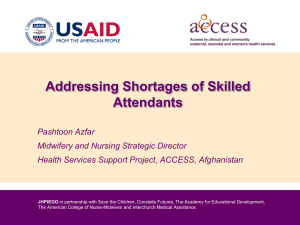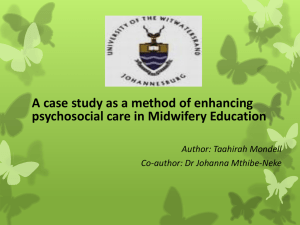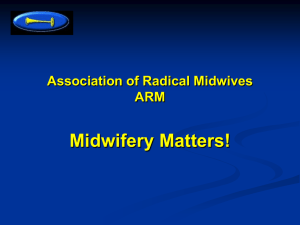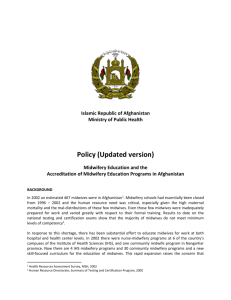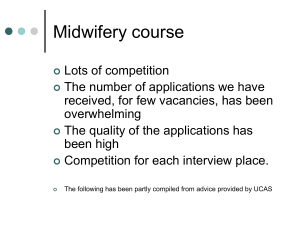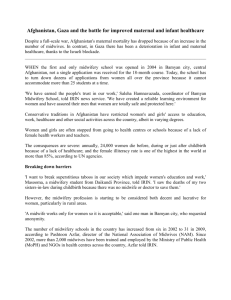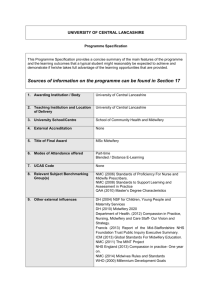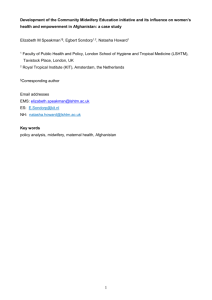FINAL_PAPER-HEALTHY_PEOPLE,_HEALTHY_COMMUNITIES
advertisement
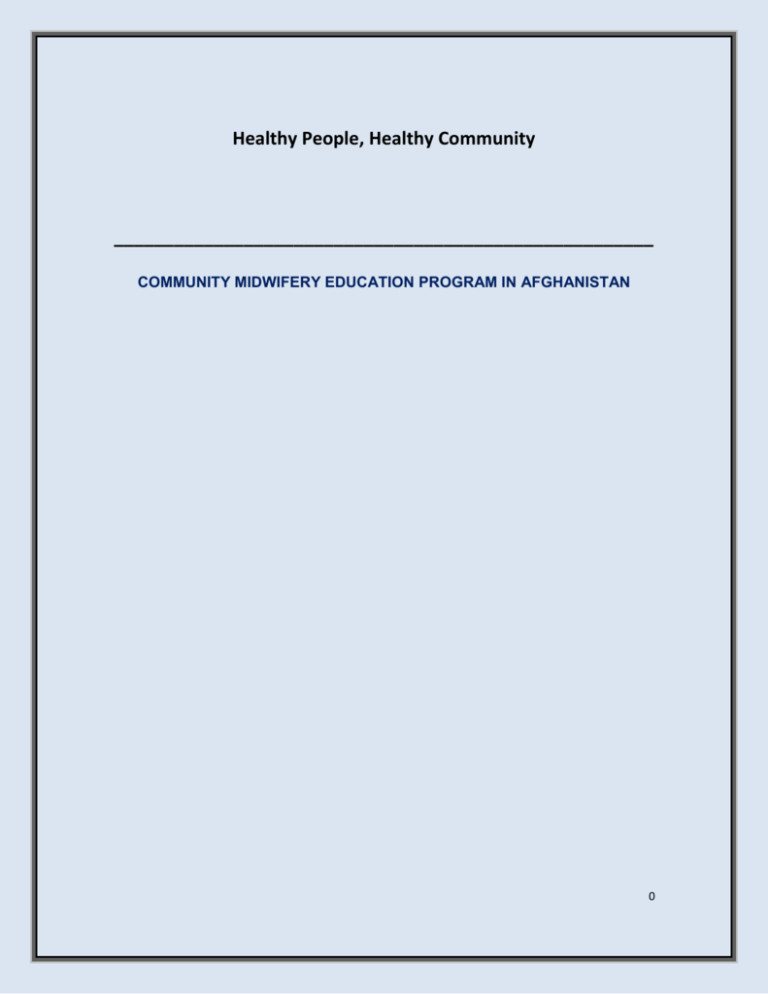
Healthy People, Healthy Community ______________________________________________________ COMMUNITY MIDWIFERY EDUCATION PROGRAM IN AFGHANISTAN 0 CONTENTS 1. 2. 3. 4. Background Information: ....................................................................................................................... 3 1.1. An overview of MCH care ....................................................................................................... 3 1.2. Human Resources Policy of the MoPH .................................................................................... 3 Vision and mission of the project: .......................................................................................................... 4 2.1. Vision: ....................................................................................................................................... 4 2.2. Mission: .................................................................................................................................... 4 Program Description:.............................................................................................................................. 5 3.1. Overview: ................................................................................................................................. 5 3.2. Goal of the project: ................................................................................................................... 5 3.3. general Objective: ..................................................................................................................... 5 3.4. specific Objectives: ................................................................................................................... 5 3.4.1. Objective #1.............................................................................................................................. 5 3.4.2. Objective #2.............................................................................................................................. 6 Implementation and management plan ................................................................................................... 6 Implementation plan ............................................................................................................................... 6 4.1.1. Selection of Students ................................................................................................................ 6 4.2. Management Plan: .................................................................................................................... 6 4.2.1.1. 5. Proposed collaboration: ........................................................................................................ 7 Operational Plan: .................................................................................................................................... 7 5.1. Preparation ................................................................................................................................ 7 5.1.1. arrangement of Classroom Facilities ........................................................................................ 7 6.2.4. Availability of Learning Resources .............................................................................................. 7 5.1.2. 6. Preparation of a Simulated Practice Environment .................................................................... 8 Teaching plan ......................................................................................................................................... 8 6.1. Teaching method: ..................................................................................................................... 8 1|P a g e 6.2. 7. Teaching Environment.............................................................................................................. 8 Program Sustainability ........................................................................................................................... 9 2|P a g e 1. BACKGROUND INFORMATION: 1.1. AN OVERVIEW OF MCH CARE Emerging from more than three decades of continuous conflict, war, and insecurity, less or no access to quality health care in hard to reach areas, financial instability and donor dependency of the country had leaded the entire health care specially the MCH care to be worse in Afghanistan among the world. The United Nations Children’s Fund (UNICEF) estimates that Afghanistan has the second highest maternal mortality in the world. More than 25,000 Afghan women die in childbirth each year, an estimated 1,600 maternal deaths per 100,000 live births and 165 infant deaths for every 1,000 live births are the statistical findings accepted by the Ministry of Public health of the Islamic republic of Afghanistan. As discussed above the main reason for the high mortality rate is the lack of health care professionals. Currently, only 10 percent of births are assisted by trained professionals. Under Taliban rule, women’s health care and education were neglected, and no midwives were trained between 1996 and 2003. Due to traditional and cultural restrictions, male doctors or health attendants cannot help women give birth yet. Roughly 40 percent of health facilities lack skilled female birth attendants to deal with emergencies. Factors Associated with High Maternal and Child mortalities: The following are the major contributing factors associated with high maternal and child mortalities. Hemorrhage Sepsis Pregnancy Induced Hypertension Unsafe abortion and others 1.2. HUMAN RESOURCES POLICY OF THE MOPH The Basic Package of Health Services (BPHS) was developed in early 2003, with the aim to provide basic and essential primary care services where all Afghans should have equal access to these services. Within this package, community midwives are recognized as key healthcare providers while there is great enthusiasm at this time for the standardization and expansion of midwifery education in Afghanistan. Various estimates have been made regarding the need for trained and competent midwives in the country despites of having midwives training some 3040 years before, new cadres of midwives graduating by CME programs; but conclusively still there is an alarming shortage of trained female staff with midwifery skills. Therefore, programmatic strategies must be directed at aggressively supporting: 3|P a g e To increase in the number of skilled midwives; Focused on preparation and deployment of midwives to rural areas; Improvements in the quality of midwifery care; and Expansion of the role of midwives and scope of midwifery practice. The current National Policy on Human Resource Development for Health describes two cadres of midwives: the hospital midwife, trained at the various campuses of the Institute of Health Sciences based in several cities throughout Afghanistan, and the community midwife. 2. VISION AND MISSION OF THE PROJECT: 2.1. VISION: The program’s vision is to see the realization and development of a vibrant and vital civil society in Afghanistan where the interest, concerns, and dignity of the civilians, the citizen, and the common man are taken seriously and more people have access to resources and power over choices. 2.2. MISSION: The program will contribute to bring about and support genuine and coherent development practice among people, organizations, and institutions working for the development of Afghan Nation through civil society development, capacity building, service delivery and research. The program is committed to achieve its mission through transparent, equitable, professional, ethical and gender sensitive services with dignity to human being. Sustainable development is bringing desired positive changes in a community through enabling and capacitating the target communities to identify and respond to their perceived needs. This is the only way of bringing about a true sustainable and manageable Afghanistan-oriented development. Sustainable development is not something that could be (and neither should be) attained overnight, but extreme caution should be exercised to maintain provision of basic assistance to the community, while gradually The program’s Development Model introducing community-oriented practices and disciplines. developmental 4|P a g e 3. PROGRAM DESCRIPTION: 3.1. OVERVIEW: The program intends to contribute to the reduction of maternal and newborn mortality by increasing the quality of clinical services in the maternity wards of the regional hospitals in the country. The program is committed to achieve the above mentioned goal by graduating ‘20’ Community midwives in each province from a competency-based midwifery-training course that adheres to the Ministry of Public Health (MoPH) training program over the Eighteen (18) months period. In the process of offering this training, the program expects to build the capacity of Midwifery Accreditation Board /MoPH as a training institution by improving the instructional and clinical supervision skills of Midwifery Accreditation Board instructors, the quality of the Midwifery Accreditation Board training facilities and Midwifery Accreditation Board / MoPH management systems. Further, the program expects to assist the clinical facilities in the region in providing quality supervision and guidance to the trainees by offering “refresher training” programs to medical staff members. Finally, it expects to work with local partners, including health committees, NGOs and MoPH employees to identify and select trainees and to ensure that they are successfully deployed in appropriate clinical settings after the completion of the training period in their own origins. 3.2. GOAL OF THE PROJECT: The goal of CME is to assist high quality community midwife training programs that will prepare skilled rural providers of maternal and newborn health services, and support the midwife/midwifery student in the classroom, hospital and community. 3.3. GENERAL OBJECTIVE: To train and graduate ‘20’ competent community midwives who are selected from remote and rural areas of the provinces over ‘24’ months period. 3.4. 3.4.1. SPECIFIC OBJECTIVES: OBJECTIVE #1 Improve the quality of clinical services in the maternity wards of the Provincial hospitals, and the Emergency Obstetric Care (EmOC) of the District Hospitals (DHs), CHCs, and BHCs of the provinces. It has been observed that access of females to quality Health care is still an issue of concern around the entire country. With the training and development of the competency based skills of 5|P a g e community midwives, access to quality health services by females will improve in the maternity wards of regional hospitals, DHs, CHCs, BHCs and at the community level. 3.4.2. OBJECTIVE #2 Expand the role of midwives in delivering services in the maternity wards of Regional (Civil) Hospitals and the CHCs, and BHCs in the provinces. Training of qualified and competent midwives in the country will address the issue of lack of professional staff in many of the health facilities at the districts and community levels. 4. IMPLEMENTATION AND MANAGEMENT PLAN IMPLEMENTATION PLAN The project will be implemented and managed with a clear understanding and division of the responsibilities. Similarly technical assistance of the UNICEF, PPHD, and BPHS implementing partner will be requested upon needs. Through the ‘24’ students will be selected in the beginning, but sets its objective of graduating ‘20’ midwives according to the consensus that there are a percentage of drops out of students. Culturally acceptable, feasible and accessible training, accommodation and transportation facilities will be provided to the students and teachers at the center of each Province. The program will also facilitate the deployment of these students after graduation with the support of PPHD and BPHS implementing NGOs working in their provinces. Adequate support staff will be provided to the school and the hostel to ensure the learning environment meets the approved criteria. 4.1.1. SELECTION OF STUDENTS The program will identify the health facilities that need community midwives in discussion with local shuras (community gathering) and will select students. The students should meet all the requirements and their families will give a letter of commitment that they will allow her to attend the school for the period of training without any interruption. It is possible that most of the literate women from communities will reside inside the city or close to the city; in such case the program will select students from the city however with different geographic presence within the province or neighboring provinces. 4.2. MANAGEMENT PLAN: Areas of responsibility: There are seven areas of responsibility involved with this program: Policy oversight Technical oversight Administrative oversight Financial oversight Daily Administration 6|P a g e Instructional oversight Clinical oversight 4.2.1.1. PROPOSED COLLABORATION: The following important bodies would be contacted to play their important roles in the implementation and sustainability of the program: CDCs and Communities: Information sharing with communities and families, supporting and monitoring progress of the project, coordinating with government authorities, supporting the program in the selection of students, security maintenance and support in staffing etc Public Health Department: Ensuring involvement and support of hospitals staff during practical work, monitoring, supporting the process of students selection etc Midwifery Accreditation Board: Technical assistance, conduction of assessments, monitoring and evaluation Religious Leaders and Influential: Influencing needs of the midwifery education. UNICEF: Provision of technical and financial assistance/supplies, coordination, supervision, monitoring and evaluation, District and Provincial Government authorities: Supporting the process of students selection, security maintenance Development Partners and BPHS implementing NGOs: Coordination and ensuring that no duplication of efforts takes place, deployment of the CME students in relevant health facilities after successful graduation. 5. OPERATIONAL PLAN: 5.1. PREPARATION Upon completion of the student selection (before end of second month of the project) all learning resource package material would be provided and using the CME standards the entire infrastructure will be furnished and well equipped with all needed resources. Classroom sessions will be commenced using the standard schedule and training outline for CMW program. 5.1.1. ARRANGEMENT OF CLASSROOM FACILITIES Classrooms will be available for interactive presentations (e.g., illustrated lectures) and group activities. Seating in classrooms should be comfortable and lighting and ventilation adequate. At a minimum, a writing surface will be provided for each learner, and a chalkboard and/or flipchart, chalk and/or felt pens, and if possible an overhead projector will be available in each classroom. 6.2.4. AVAILABILITY OF LEARNING RESOURCES 7|P a g e It will ensure learners have access to reference materials and other learning resources for the duration of the training program. These materials and resources will be available at the school, and include reference manuals and other relevant printed materials; anatomic models such as a childbirth simulator, pelvic and fetal models, and a newborn resuscitation model, necessary supplies and equipment for practicing with the models such as gloves, drapes, etc. There will be a video cassette player and monitor for viewing educational videos. 5.1.2. PREPARATION OF A SIMULATED PRACTICE ENVIRONMENT A simulated practice environment provides students with a safe environment where they can work together in small groups, watch technical videos, and practice skills with anatomic models. The program will ensure a room is dedicated to simulated practice or a room at a clinical practice site for this purpose. The simulated practice environment will have the necessary supplies and equipment for the desired practice sessions. 6. TEACHING PLAN 6.1. TEACHING METHOD: It will be highly participatory, competency based lecture method where students will improve their knowledge and skills in, Problem solving, critical thinking, decision-making and appropriate interpersonal communications Competency in a range of essential clinical skills for basic maternal and newborn care and for the management of common complications in pregnancy and childbirth In addition, the learning process will incorporate topics for improving the managerial and administrative skills of these community midwives in order to develop efficient plans and administer all tasks in efficient way during their field and official works. 6.2. TEACHING ENVIRONMENT The teaching environment will be proactive, interactive and supportive in a way to have the following facilities: The environment will be set in a way that the students will practically learn problemsolving and critical thinking skills and behaves in a way to respect and respond to a patient’s/client’s perceived needs The teaching curriculum should be standard to reflects the essential midwifery competencies adopted through adult learning approach 8|P a g e Teachers should be practically prepared to demonstrate competency based learning approach Involving competent clinical preceptors who are able to use competency-based assessment tools Facilitating comprehensive, supervised clinical learning experiences that will enable the development of essential skills for basic maternal and newborn care and for the management of common complications in pregnancy and childbirth Including evaluation methods that assess knowledge, skills, and attitudes. 7. PROGRAM SUSTAINABILITY Sustainable development is bringing desired positive changes through enabling and capacitating the communities to identify and respond to their perceived needs. Sustainable development is not something that could be attained overnight, but extreme caution should be exercised to maintain provision of basic assistance, while gradually introducing area-specific developmental practices and disciplines. This program aims to work closely with the community, local partners, the private sector, and the Ministry of Public Health at both provincial and national levels to ensure the effective and sustainable Midwifery Training Program. Community Sustainability activities aim to establish health services not just fully acceptable to the community, but fully supported by all its members. The program will involve community members in the recruitment of midwifery candidates, as part of creating strong ties and linkages with the community. Community trust and institutional sustainability is the only tool to preserve a long life for current and new health services. 9|P a g e
